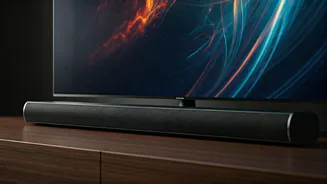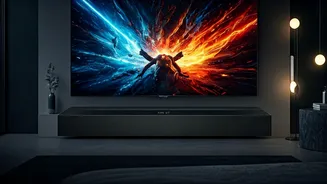Soundbar Essentials Defined
Soundbars represent a streamlined approach to home audio, packaging multiple speakers into a single, elongated enclosure. This design offers a significant
advantage over traditional multi-speaker systems, especially in terms of space efficiency and ease of setup. Unlike complex surround sound setups that involve multiple speakers, receivers, and intricate wiring, soundbars simply connect to your television via a single HDMI or optical cable. This simplicity appeals to many consumers. Soundbars often integrate multiple drivers within their compact design, some even include upward-firing drivers for height channels and simulate surround sound effects. This allows them to produce a wider soundstage, creating a more immersive experience without requiring numerous satellite speakers. This design is also perfect for smaller living spaces or those who value a clean, uncluttered aesthetic. They offer a more affordable entry point into better audio than many full surround sound systems. Many come equipped with features such as Bluetooth connectivity, allowing you to easily stream music from your smartphone or tablet. In short, they deliver a user-friendly and aesthetically pleasing audio solution.
Sound Quality Matters Most
The primary purpose of a soundbar is to improve your television's audio, and sound quality is paramount. Several factors contribute to a soundbar's sonic performance. First, consider the number and type of drivers. High-quality drivers, built to handle a wide range of frequencies, provide a balanced sound profile. Soundbars with dedicated tweeters often deliver better high-frequency clarity. A subwoofer enhances low-frequency response, delivering powerful bass that enriches the overall listening experience. When considering sound quality, pay attention to the soundbar's frequency response range. A wider range means the soundbar can reproduce a broader spectrum of sounds. Consider the soundbar's power rating, typically measured in watts (W). A higher wattage generally indicates a louder sound output. Soundbars use various technologies to create a virtual surround sound experience, though these are often simulated. Check for support for Dolby Atmos or DTS:X, two of the leading surround sound technologies that use object-based audio to create a more immersive 3D audio experience. Some models also come with sound modes optimized for various content types, such as movies, music, or news. Select a soundbar with the right balance of features to match your entertainment preferences.
Connectivity & Features
Modern soundbars come packed with connectivity options and features designed to enhance user experience. The most common connection is via HDMI, supporting Audio Return Channel (ARC) or Enhanced ARC (eARC). ARC allows the soundbar to receive audio from your TV and send audio back to the TV. eARC offers higher bandwidth, supporting lossless audio formats like Dolby Atmos. Optical digital audio is another common method, though it may not support the latest audio formats. Bluetooth connectivity allows for easy wireless streaming from smartphones, tablets, and other devices. Consider whether the soundbar includes Wi-Fi for streaming services like Spotify or Apple Music. Many soundbars feature built-in voice assistant compatibility, such as Amazon Alexa or Google Assistant. This lets you control playback, adjust volume, and perform other functions with voice commands. Look for a soundbar with a user-friendly remote control or a companion app for easy setup and operation. Soundbars also support a range of audio codecs, such as Dolby Digital, Dolby TrueHD, and DTS. Ensure the soundbar supports the codecs used by your content sources for the best audio quality.
Placement & Setup Strategies
Proper placement of your soundbar is crucial for optimal sound quality. The ideal position is directly beneath your television, ideally centered horizontally. This placement minimizes interference and promotes a cohesive audio experience. Many soundbars are designed to be mounted on a wall or placed on a TV stand. Wall mounting can save space and create a cleaner look, while placement on a stand offers more flexibility. Consider your room's acoustics. Hard surfaces, like bare walls and floors, can reflect sound and create echoes, while soft surfaces, like carpets and curtains, absorb sound and reduce reflections. Some soundbars feature room correction technology that automatically calibrates the sound output to match the room's acoustics. Consider the listening position. The soundbar's sound should ideally be directed toward your primary listening area. If the soundbar has upward-firing drivers, ensure there's no obstruction above. Carefully review the setup instructions to ensure that connections are made correctly and the soundbar is powered on. Many soundbars feature an automatic setup process that simplifies configuration.
Matching TV and Soundbar
Selecting a soundbar that complements your television is essential for a harmonious home entertainment setup. The size of your TV plays a role in determining the ideal soundbar size. For smaller TVs (e.g., 32-43 inches), a compact soundbar is usually sufficient. Larger TVs (55 inches and above) often pair best with longer soundbars that can deliver a wider soundstage. Compatibility is key. Ensure the soundbar supports the same audio formats and connectivity options as your TV. If your TV supports eARC, consider a soundbar that also has eARC for the best audio experience. The aesthetics of your setup matter. Choose a soundbar with a design that complements your TV and your overall home decor. Some soundbars are designed to sit flush with the bottom of the TV, offering a streamlined look. Others are more pronounced, adding to the visual appeal. Compare reviews to assess how well different soundbars perform with different types of content, like movies, music, and gaming. Prioritize soundbars known for their audio quality. If you are also purchasing a new TV, consider buying both products at the same time to ensure compatibility and integration.












